
https://www.youtube.com/watch?v=t5cJB6JL0_k
Underwater Constructions _ How do Engineers Make Them
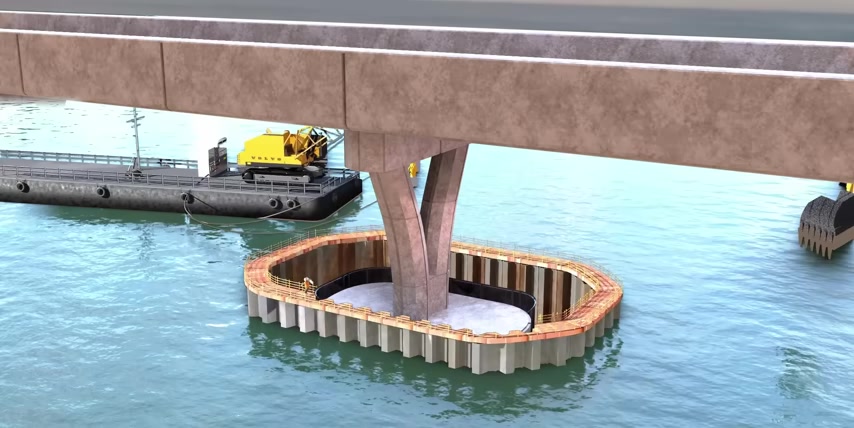
Many laborers are fighting hard against the violent ocean currents to complete the construction of an underwater bridge pier .
Are you able to spot a mistake made by the chief construction engineer here ?
This mistake will result in catastrophe .
Welcome to civil engineering's most challenging task , underwater construction .
Even though we call it underwater construction .
Today's engineers avoid water altogether .
When building an underwater structure to remove water from your construction area , you must first build a temporary dam called a coffer dam .
Working directly under the water is far from a practical method .
The next question that arises is how to build the coffer dam under the water .
The first step is to erect these guide piles with the help of a pile driving hammer machine .
The guide piles provide guidance for the construction of the coffer dam .
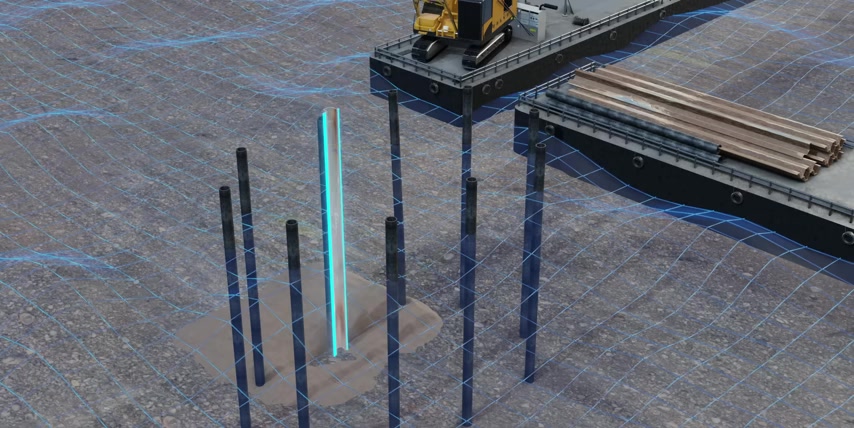
Then workers will drive many sheet piles in the soil with the help of the same machine .
These sheet piles have interlocking connections at both ends of the section .
Such a clever interlocking mechanism means that water leakage will be minimal .
The sheet piles are driven under the ocean bed till they reach the bedrock .
The order of piling is from the corner to the center , the alignment can be maintained this way .
Have you noticed anything special about the pile driving hammer machine ?
It isn't just pushing the sheet piles down .
You can imagine easily what would happen if the sheet piles were pushed into the soil to penetrate the soil .
The machine uses vibration .
If you observe carefully , you'll see these tiny but fast vibrations .
The specialty of this machine lies in the fact that it consists of two counter rotating eccentric weights .
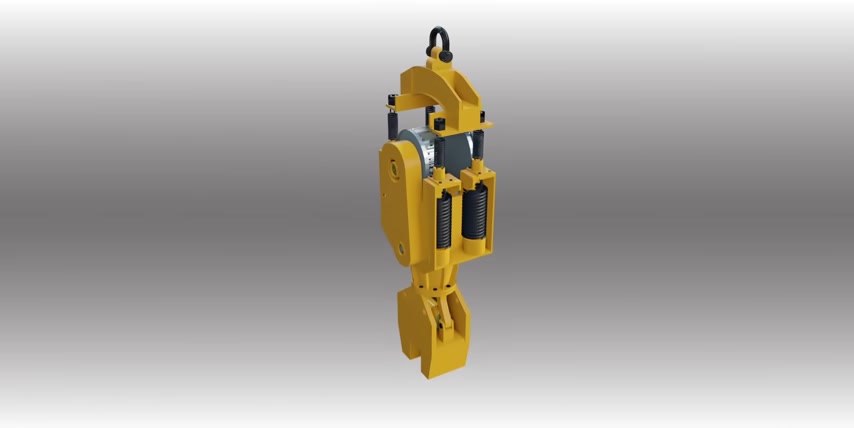
The purpose of these weights is to induce vibration in a machine .
This flat surface looking ship called a barge is employed to carry machinery and components that are required on the construction site .
Now we're ready for the big phase of the construction project pumping out the water from the coffer dam .
However , before doing all this work , the engineers had a major assignment to do .
Let's see what this was before getting into the water pumping phase .
The engineers of the project had to do a detailed geotechnical study of the soil on which the coffer dam was going to be constructed .
They selected the land so that it would be able to carry the load of the permanent structure .
The most commonly used test for measuring soil strength is an in situ test called a cone penetration test .
You can see how the cone penetration test device is kept on the ocean bed .


The conical tip of the device penetrates in the soil and sensors send back friction and soil resistance values .
They will continue the penetration till the point they reach the bedrock .
You can see the sudden jump in the resistance value .
Once the bedrock is reached with the help of this handy test , the engineers know how deep the sheet piles must be driven , the sheet piles should reach the bedrock .
Now , let's jump back to the project and begin pumping water out as the water level lowers .
You'll notice water leakage between the sheet piles .
This is due to differential pressure of the water , single layer sheet piles are failing .
So we need to double them .
The space between these walls of sheet piles is generally filled with granular material such as sand , gravel or broken rock .
This double layered coffer dam will effectively resist water leakage between the sheets .
Now let's remove all the water from the coffer dam .

Luckily there's no visible water leakage .
Oh no .
What happened ?
The entire coffer dam collapsed inward .
Earlier when the water was present on both sides , the force acting on the coffer dam due to the water pressure was being canceled out .
You can easily understand the reason for this .
However , when the water from this volume disappears , there will be a huge inward force which destroys the coffer dam .
The inward collapse of sheet piles can be prevented by erecting a bracing frame structure by the side of the sheet piles .
The bracing frame system comprises components like whales struts and braces .
The connection between these whales and struts is bolted .
As illustrated here , these horizontal members called struts provide lateral support which can resist inward movement to the coffer dam walls .
The coffer dam is super strong now and it's reached the bedrock .
Let's dry the water .
Now , can you predict what will happen ?
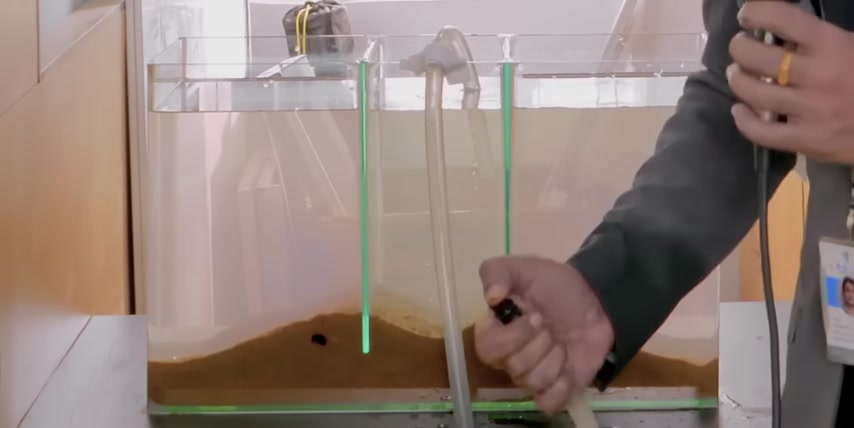
Now , here , I have made a coffer dam a small but cute coffer dam , isn't it ?
Let's see .
Now , what happens if I remove water from the coffer dam , I'm removing the water .
Did you see that ?
A beautiful U shape ?
The water particles are traveling like a U shape below the coffer dam .
This is because of the water partial differential .
The same thing will happen inside our coffer dam as well .
When you remove water from that similar to the experiment , water seepage happens in our coffer dam .
Also , the technique to prevent water seepage are difficult to accomplish .
So let's pump this seepage water out continuously .

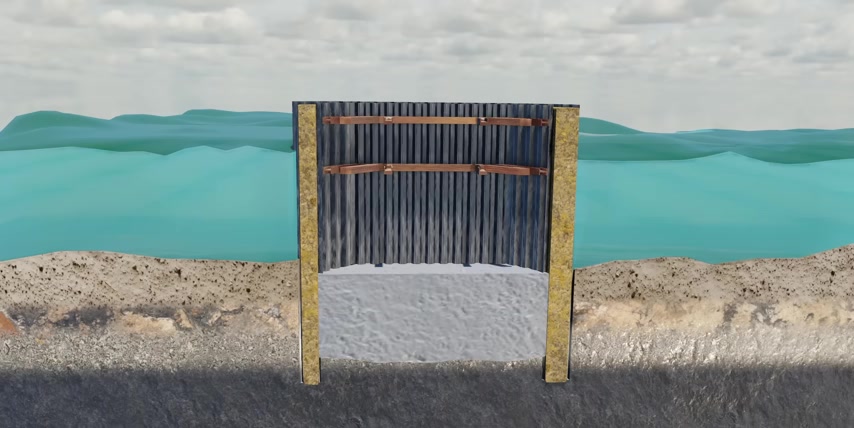
If the soil above the hard strata is removed and concreting is done on the hard strata .
Our underwater project is half done .
This is called the concrete seal course technique .
The concrete seal course will also act as a strong footing preventing any water leakage .
Let's see how this is done .
The removal of the soil from the coffer dam is usually done using clamshell buckets .
These buckets are operated by an excavator , doesn't the operation of the clamshell bucket look pretty cool .
You know the next stage , concrete seal course to make sure the concrete seal course is bonded strongly with the bedrock .
We need a few piles which penetrate into the bedrock .
The vibrating hammer machine comes to help again , it pushes a few hollow steel pipes into the bedrock .
The hard rock within this cylinder is removed with the help of an auger machine .
Now it's time to place reinforcement bars into the cavity and pour concrete .

Once the piles are ready , we can build the concrete seal course above .
Since seepage , water is present on this base .
Always the seal course .
Concreting is carried out using the Remi method .
This includes a hopper bucket and a long segmented pipe .
Specialized cement with high workability is used to concrete .
The floor , a thick plug is installed at the bottom of the remi pipe to prevent water from getting inside the pipe .
After some time , this pipe is lifted with a jerk , causing concrete to pour down and the bottom plug to be removed .
During this process , the discharge end of the trey pipe is continuously kept submerged in the concrete so that the concrete which is getting poured is less likely to mix with the surrounding seepage water .
Now that the concrete seal course is ready , it's time to tackle the remaining construction work .
The water seepage is efficiently blocked by this structure .
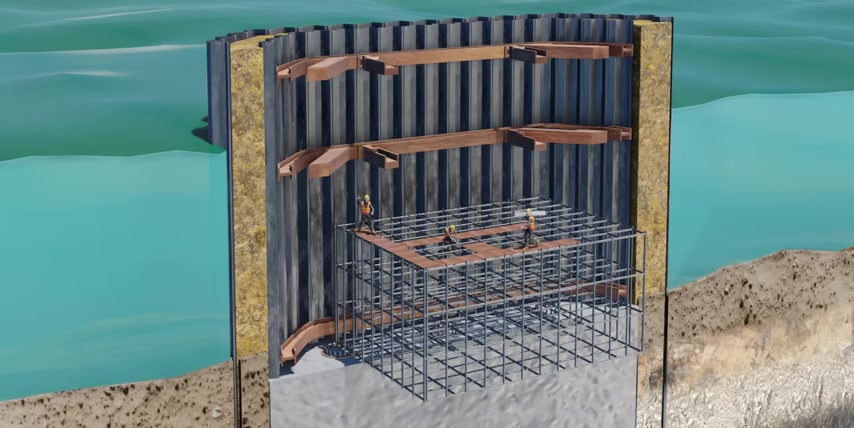
Workers lay out the skeleton of high quality reinforced bars to construct the footing shaft of the bridge pier because the bridge pier structure is going to remain in the water .
Engineers ensure that the materials to be used in the construction are of the best quality .
They must successfully bear the water pressure as well as the load of the bridge as the skeleton of the bridge pier keeps on progressing .
Arrangements are made to pour concrete in the structure once concrete is completely poured into the skeleton , this structure is kept undisturbed to gain strength .
Usually a bridge pier takes 14 to 28 days to gain complete strength .
Once the bridge pier gains enough strength , the coffer dam is of no use and is an eyesore .
So the engineers remove it .
However , removing the coffer dam below the level of the concrete seal course can affect the strength of the whole structure .
As a result , engineers cut the sheet piles at this level .

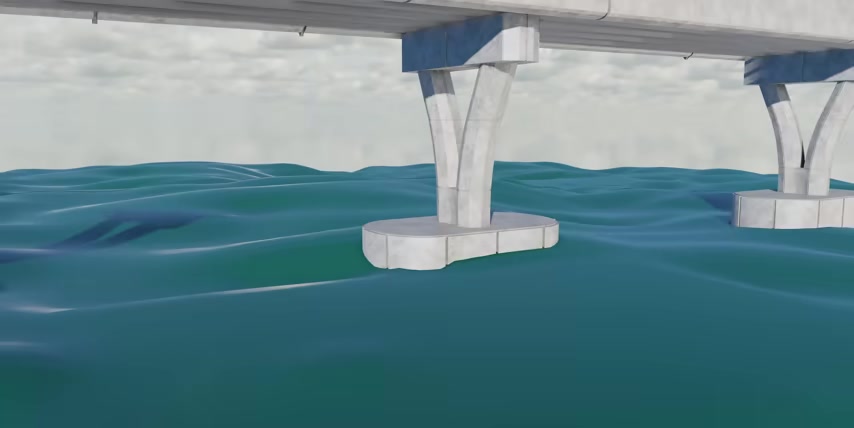
Here it is this strong bridge pier is ready to support a heavy bridge .
I hope you enjoyed the video on underwater construction technology using coffer dams , but this is a different kind of underwater construction technology known as Ken and that one is again different called a pile foundation .
We will cover about these technologies in a different video .
But before leaving this video , please consider us to support us on Patreon .
That will make a difference .
Thank you .
Take care .
Bye bye .
Are you looking for a way to reach a wider audience and get more views on your videos?
Our innovative video to text transcribing service can help you do just that.
We provide accurate transcriptions of your videos along with visual content that will help you attract new viewers and keep them engaged. Plus, our data analytics and ad campaign tools can help you monetize your content and maximize your revenue.
Let's partner up and take your video content to the next level!
Contact us today to learn more.